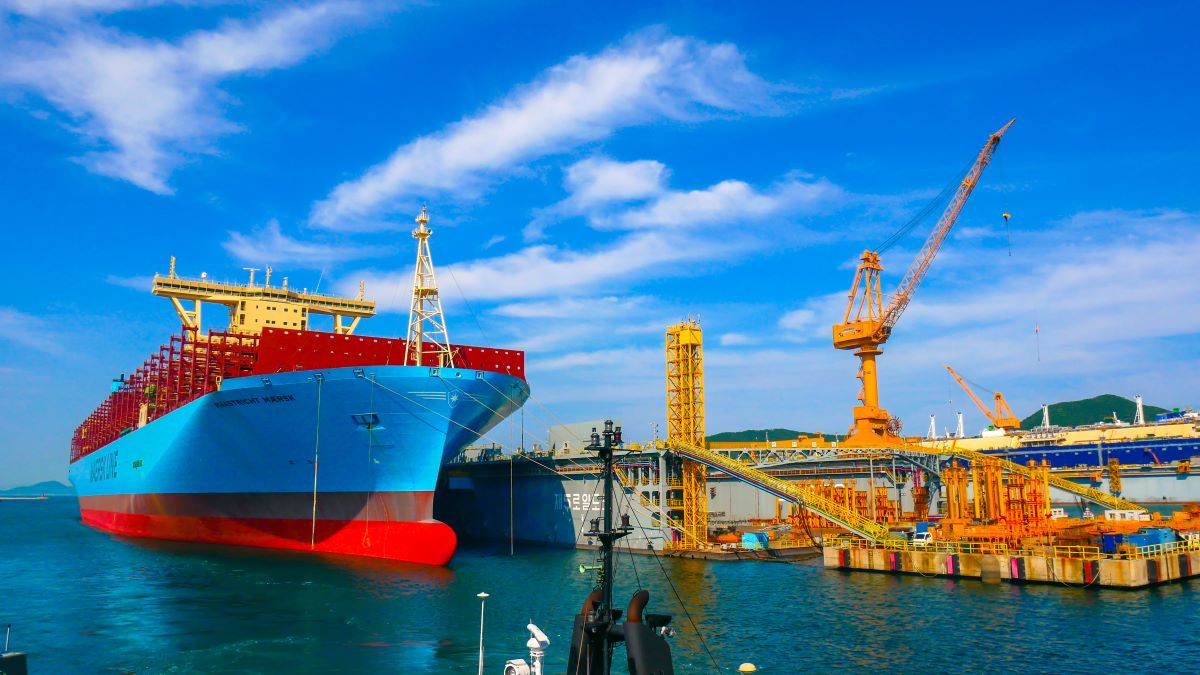The shipbuilding industry in South Korea is critical to the economy and forms a part of the maritime sector contributing 10% of the GDP. Large gas carriers, bulk carriers, oil tankers, and container ships are manufactured as a part of this industry.
On a global level, South Korea has become one of the topmost players in this industry due to its large shipbuilding capacity, R&D initiatives, and technological advancements. The production of high-value-added ships like gas carriers and container ships has given South Korea a competitive edge over other countries. According to Clarksons’ Maritime & Shipping Research Services, in October 2023, South Korean shipbuilders bagged 62% of the total global orders, outpacing its biggest competitor China.
Also, shipbuilding contributed $9.22 bn to the country’s exports in the first half of 2023, signifying an 11.9% year-on-year increase. This was primarily due to a sharp climb in demand for LNG tankers, partly due to the Russia-Ukraine war as well as the eased visa requirements for overseas workers.
Government initiatives boost South Korean shipbuilding
The shipbuilding industry in South Korea has received consistent government support under all circumstances. The country’s Ministry of Trade, Industry & Energy (MOTIE) wants it to maintain global tech supremacy in shipbuilding and aims to increase its market share from 64% to 75% by 2030. As a part of the initiative, the shipbuilding industry would receive KRW 140 bn ($97.2 mn) in government funding for the latest research and development.
Moreover, the South Korean government wants to expand its role in upgrading to the next generation of shipping. Thus, it aims to additionally invest over $534 mn over the next five years to channelise efforts in new technologies, alternative fuels, and enhancing manufacturing capabilities. It encourages shipbuilders to focus on premium vessels and the eco-friendly segments of the market.
This should also help the nation’s shipbuilders to stave off competition from lower-priced Chinese ships, counter the declining order volumes, and enhance the industry’s profitability.
The eco-friendly offerings include LNG and LPG carriers, methanol, and ethanol-fuelled ships as well as battery-operated ones. Another data by Clarkson revealed that between January to June 2023, South Korea supplied 87% of the large LNG carriers, making it a global leader in this segment.
South Korea to explore US market and autonomous shipping for expansion
MOTIE Vice Minister Youngjin Jang stated, “With the global shipbuilding industry’s upturn adding a tailwind to Korea’s shipbuilding industry, we expect to see great opportunities for making a rebound and new leap.” MOTIE also aims to capture over 80% of the next-generation shipbuilding market. Thus, the nation is also exploring various technologies for autonomous shipping.
Besides, South Korean shipbuilders seek naval shipbuilding opportunities in North America. Hanwha Ocean has made a major move into the North American defense industry by establishing a local subsidiary, Hanwha Ocean US Holding Company with an initial investment of $324.88 mn. The Head of South Korea’s Defense Acquisition Program Administration (DAPA), Dong-hwan Eom affirmed, “In the future, we plan to establish a strategic cooperative relationship between the governments and shipbuilding industries of both countries and based on this, we will actively support domestic shipbuilders in entering the US market through various means such as the US Navy’s ship repair and new ship construction projects.”
Labour shortage and low-cost Chinese vessels pose challenges
Notwithstanding the growth opportunities, the shipbuilding industry in South Korea also faces several challenges. The lack of trained workers in the shipyards is one of the major difficulties. According to the Korea Offshore & Shipbuilding Association (KOSHIPA), the number of workers in the industry plunged to 95,000 at the end of 2022 from 203,000 at the end of 2014.
However, to address this shortage, South Korea’s Ministry of Trade, Industry, and Energy plans to further improve the visa system to achieve its main goal of increasing the E7 visa quota from only 2,000 in 2022, to 35,000 in 2023.
Meanwhile, Korean shipbuilders are also investing in high-end robots to address the labour shortage that poses an impediment to the rising shipbuilding orders from global clients.
The South Korean shipbuilding industry also faces tough competition from China. The latter’s dominance in low-cost vessels and technological innovation poses a mounting challenge for the nation. However, industry analysts believe that although Chinese shipyards have a large capacity for bulk and container vessels, South Korean shipbuilding firms are better in terms of design and model development.










 Australia
Australia China
China India
India Indonesia
Indonesia Japan
Japan Malaysia
Malaysia Philippines
Philippines Singapore
Singapore South Korea
South Korea Taiwan
Taiwan Thailand
Thailand Vietnam
Vietnam Germany
Germany Hong Kong
Hong Kong USA
USA Switzerland
Switzerland Singapore
Singapore
 United Kingdom
United Kingdom








